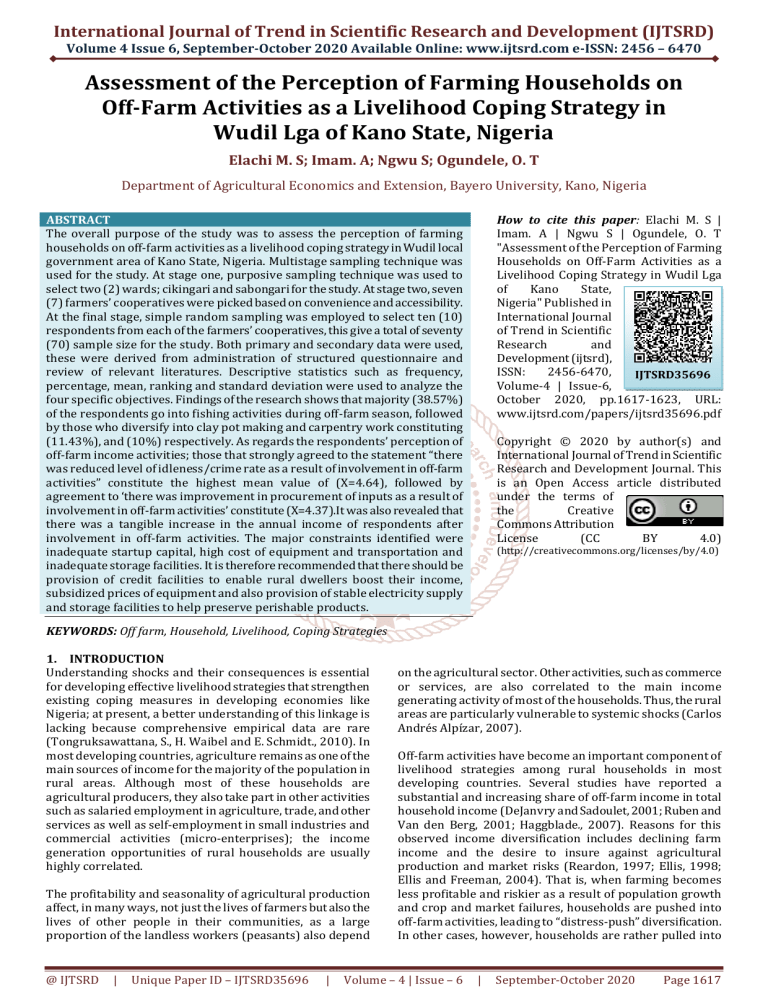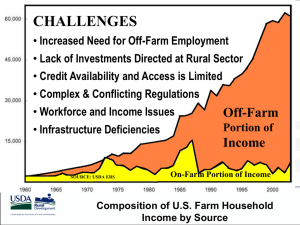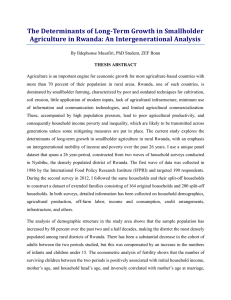
International Journal of Trend in Scientific Research and Development (IJTSRD)
Volume 4 Issue 6, September-October 2020 Available Online: www.ijtsrd.com e-ISSN: 2456 – 6470
Assessment of the Perception of Farming Households on
Off-Farm Activities as a Livelihood Coping Strategy in
Wudil Lga of Kano State, Nigeria
Elachi M. S; Imam. A; Ngwu S; Ogundele, O. T
Department of Agricultural Economics and Extension, Bayero University, Kano, Nigeria
How to cite this paper: Elachi M. S |
Imam. A | Ngwu S | Ogundele, O. T
"Assessment of the Perception of Farming
Households on Off-Farm Activities as a
Livelihood Coping Strategy in Wudil Lga
of
Kano
State,
Nigeria" Published in
International Journal
of Trend in Scientific
Research
and
Development (ijtsrd),
ISSN:
2456-6470,
IJTSRD35696
Volume-4 | Issue-6,
October 2020, pp.1617-1623, URL:
www.ijtsrd.com/papers/ijtsrd35696.pdf
ABSTRACT
The overall purpose of the study was to assess the perception of farming
households on off-farm activities as a livelihood coping strategy in Wudil local
government area of Kano State, Nigeria. Multistage sampling technique was
used for the study. At stage one, purposive sampling technique was used to
select two (2) wards; cikingari and sabongari for the study. At stage two, seven
(7) farmers’ cooperatives were picked based on convenience and accessibility.
At the final stage, simple random sampling was employed to select ten (10)
respondents from each of the farmers’ cooperatives, this give a total of seventy
(70) sample size for the study. Both primary and secondary data were used,
these were derived from administration of structured questionnaire and
review of relevant literatures. Descriptive statistics such as frequency,
percentage, mean, ranking and standard deviation were used to analyze the
four specific objectives. Findings of the research shows that majority (38.57%)
of the respondents go into fishing activities during off-farm season, followed
by those who diversify into clay pot making and carpentry work constituting
(11.43%), and (10%) respectively. As regards the respondents’ perception of
off-farm income activities; those that strongly agreed to the statement “there
was reduced level of idleness/crime rate as a result of involvement in off-farm
activities” constitute the highest mean value of (X=4.64), followed by
agreement to ‘there was improvement in procurement of inputs as a result of
involvement in off-farm activities’ constitute (X=4.37).It was also revealed that
there was a tangible increase in the annual income of respondents after
involvement in off-farm activities. The major constraints identified were
inadequate startup capital, high cost of equipment and transportation and
inadequate storage facilities. It is therefore recommended that there should be
provision of credit facilities to enable rural dwellers boost their income,
subsidized prices of equipment and also provision of stable electricity supply
and storage facilities to help preserve perishable products.
Copyright © 2020 by author(s) and
International Journal of Trend in Scientific
Research and Development Journal. This
is an Open Access article distributed
under the terms of
the
Creative
Commons Attribution
License
(CC
BY
4.0)
(http://creativecommons.org/licenses/by/4.0)
KEYWORDS: Off farm, Household, Livelihood, Coping Strategies
1. INTRODUCTION
Understanding shocks and their consequences is essential
for developing effective livelihood strategies that strengthen
existing coping measures in developing economies like
Nigeria; at present, a better understanding of this linkage is
lacking because comprehensive empirical data are rare
(Tongruksawattana, S., H. Waibel and E. Schmidt., 2010). In
most developing countries, agriculture remains as one of the
main sources of income for the majority of the population in
rural areas. Although most of these households are
agricultural producers, they also take part in other activities
such as salaried employment in agriculture, trade, and other
services as well as self-employment in small industries and
commercial activities (micro-enterprises); the income
generation opportunities of rural households are usually
highly correlated.
The profitability and seasonality of agricultural production
affect, in many ways, not just the lives of farmers but also the
lives of other people in their communities, as a large
proportion of the landless workers (peasants) also depend
@ IJTSRD
|
Unique Paper ID – IJTSRD35696
|
on the agricultural sector. Other activities, such as commerce
or services, are also correlated to the main income
generating activity of most of the households. Thus, the rural
areas are particularly vulnerable to systemic shocks (Carlos
Andrés Alpízar, 2007).
Off-farm activities have become an important component of
livelihood strategies among rural households in most
developing countries. Several studies have reported a
substantial and increasing share of off-farm income in total
household income (DeJanvry and Sadoulet, 2001; Ruben and
Van den Berg, 2001; Haggblade., 2007). Reasons for this
observed income diversification includes declining farm
income and the desire to insure against agricultural
production and market risks (Reardon, 1997; Ellis, 1998;
Ellis and Freeman, 2004). That is, when farming becomes
less profitable and riskier as a result of population growth
and crop and market failures, households are pushed into
off-farm activities, leading to “distress-push” diversification.
In other cases, however, households are rather pulled into
Volume – 4 | Issue – 6
|
September-October 2020
Page 1617
International Journal of Trend in Scientific Research and Development (IJTSRD) @ www.ijtsrd.com eISSN: 2456-6470
the off-farm sector, especially when returns to off-farm
employment are higher or less risky than in agriculture,
resulting in “demand-pull” diversification. (Vanden Berg and
Kumbi, 2006).
In addition to providing the much needed investment capital
for the farm, off-farm occupation has been seen by some
researchers as a risk minimizing strategy which is important,
especially, to the small-scale farmers. This is, indeed, a sound
safeguard against crop failure and market failure (Ellis &
Freeman, 2004; Babatunde, Olagunju,Fakayode&Adejobi,
2010).
Agricultural production in Nigeria still relies heavily on the
rural farmers who constituted about 90% of food producers
for the nation (Rahji, 2000). World Bank (1996) described
them as small scale operators, tenants or landless,
characterized by low income and nutritional deficiencies,
limited assets, large family size, high dependency ratio.
The above might have arisen because majority of Nigeria
farmers live in rural areas with the practices being so
primitive, subsistent and counterproductive that the nation
has been found wanting in her effort toward making great
supports in sufficient food production in quantity and quality
for her fast growing population (Ekong, 2003). As a result of
this problem of poor performance, many have put the blame
solely on an average Nigerian farmer who is characterized as
an irrational, conservative, ignorant and superstitious
resource allocator
1.1. Statement of the Problem
Rural households in Sub Saharan Africa live in risky
environments and very often they cannot protect their
income fluctuation or consumption from shocks. Farming
households are faced with several risks ranging from
inadequate rains/drought, degraded land, input shortages,
disease outbreak and low prices for agricultural products.
For a variety of reasons, the poor are often the least
equipped to weather the impact of aggregate shortage in
their income; they have few assets which they could sell or
use as a buffer, limited or no access to formal credit and
insurance markets to help smooth income shortage over
time, and often lack the education; where the consumption
of the good or service (such as healthcare) is necessary,
households may be faced with catastrophic spending
burdens that drive them deep into debt and destitution.
Furthermore, many of their coping strategies are either
ineffective, or create harmful consequences, especially for
children.
Also, these households have varying access to the resources
that allow them to manage risk and cope with the
consequences of shocks. Rural households not only have
varying access to resources but also to other risk-coping
mechanisms, such as informal financial transactions (in thrift
and credit associations), migration, remittances etc.
Christiansen and Subbarao (2001) as cited by Oyekale and
Yusuf (2010) submitted that the need for addressing the
issue of shocks becomes paramount because they lead to a
wide variability in households in-comes. In the absence of
sufficient assets or insurance to smoothing consumption,
such shocks may lead to irreversible losses; such as distress
sale of productive assets, reduced nutrient intake, increased
crime rate or interruption of education the children.
@ IJTSRD
|
Unique Paper ID – IJTSRD35696
|
Off-farm activities appeared to be prevalent through the
developed and developing countries as alternatives
measures through which rural farm households improve
their income (Kinsella et al, 2000). However, the extent to
which off-farm activities in recent decade have been
embraced by most rural households deserves attention
research-wise to understand why most household are
gradually diverting their resources for investment into some
non-farm income generating activities.
1.2. Objective of the Study
The broad objective of the study is to assess the perception
of farming households onoff-farm activities as a livelihood
coping strategy in Wudil Local Government of Kano state,
Nigeria, the specific objectives were to;
A. describe the socioeconomic characteristic of the farm
households in the study area,
B. describe the off-farm income activities carried out by
farm household other than farming,
C. determine the perception of farming households on offfarm income activities as a livelihood strategy, and
D. describe the constraints to off-farm income activities by
the farm households.
2. METHODOLOGY
2.1. Description of the Study Area
The study was conducted in Wudil Local Government Area,
Kano State, Nigeria.
Wudil is located 43Km South-East from the State capital and
is one of the important commercial towns in Kano State. It
covers an area extending between latitude 11o 37’N and
latitude 11o 56’N as well as between longitude 8o 45’E and 8o
57’E and has a population of 105,106 (NPC, 2006). The rainy
season lasts from April to September while the dry season
begins from October to March (Olofin, E. A., Nabegu, A. B. and
Dambazau, A. M. 2008).
The inhabitants of the area are diverse in occupation ranging
from the elite to traders and artisans with majority of its
populace using farming as a source of income. Major crops
produce are corn, rice, sugar cane, groundnut, vegetables
and with some few people engaged in fishing activities, cattle
rearing and pottery (Olofin, E. A., Nabegu, A. B. and
Dambazau, A. M. 2008).
2.2. Sampling Techniques
Multistage sampling technique was used for the study. At
stage one, purposive sampling technique was used to select
two (2) wards out of the ten (10) in Wudil Local Government
Area, the wards are as follows; Cikingari, Sabongari,
Dankaza, Kausani, Dagumawa, Utai, Darki, Achika, Lajawa
and Indabo. The two (2) wards selected were Cikingari and
Sabongari this was based on the high concentration of rural
people who engage in off-farm income activities. At stage
two, seven (7) farmers’ associations/cooperative were
picked based on convenience and accessibility. At the final
stage, simple random sampling was employed to select ten
(10) respondents from each of the farmers’ association, this
give a total of seventy (70) sample size for the study. The
choice of the sampling technique was taken in a bid to avoid
bias in the selection procedure in order to achieve precision
for a given outlay of resources.
Volume – 4 | Issue – 6
|
September-October 2020
Page 1618
International Journal of Trend in Scientific Research and Development (IJTSRD) @ www.ijtsrd.com eISSN: 2456-6470
2.2.1. Sample Frame
A proportion of (10%) was taken and ten (10) respondents
were chosen from each farmer’s association selected since
the sample size is known.
2.3. Data Collection
Both primary and secondary data were used for the research
work. The primary data was a cross-sectional data obtained
using structured questionnaire while secondary gotten by
reviewing relevant literatures. Interview and questionnaire
were used as data collection instrument. The questionnaire
has four (4) sections; section one contains questions on
socioeconomic characteristic of the respondents, section two
on types of off-farm activities engaged, section three
contains a 5 points Likert scale statements on perception of
off-farm activities while the last section has provided
parameter on the constraints faced by the respondents
during the course of engaging in off-farm activities.
2.4. Analytical Techniques
The data collected from the field were entered into SPSS
version 18 after coding and cleaning. Descriptive statistical
tools were used to analyzed the data. Objective i, ii, iii and iv
was analyzed using frequency, percentage, mean, standard
deviation and ranking.
3. RESULT AND DISCUSSION
3.1. Information on Socio-economic Characteristics of
the Respondents.
An individual’s feelings, thought, understandings,
predisposition, etc. are dependent on various aspects of that
person’s mental makeup and situation. The socio-economic
characteristics investigated includes age, marital status,
gender, household size, level of education, farming
experience, annual income and occupation they were
analyzed using descriptive statistics.
3.1.1. Age
Age factor is very important in terms of labor especially
where there are poor technologies. In such situations, one
expects the young to be better position to be more
productive ultimately. (Igben,1988). The result in table 1
below shows that most (30%) of the respondents were in
the age category of 31-40 years, the age category of 41-50
years constituted (28.57%), the age category of 21-30years
constitutes (22.86%) while age category of 51-60 years
constitutes the least proportion (18.57%).
3.1.2. Gender
Gender refers to the natural segregation of the human race
into male and females and represents the sex of the
respondent under study (Web 2015). Majority (97.14%)
were males while (2.86%) were found to be females. This
implies that male engage more in off-farm income activities
than female in the study area due to their attempt to
diversify to meet households demand financially as
household heads. This is in agreement with the finding of
Shu’aib (2009) who found out that traditionally, gender
segregation gives room for the division and assignment of
responsibilities among people. According to the author, this
led to the categorization of jobs and activities as males tend
to undertake more tedious and outdoor jobs, females were
left with simpler and indoor activities.
3.1.3. Marital Status
Marriage makes an individual more responsible and takes
relatively technical decision more accurately. The result
from the study shows that majority (58.57%) were found to
be married, some of the respondents (20%) were divorced,
those who are not married constitute (11.43%) and
widowed constitute (10%) respectively. This implies that
married people with many household members diversify
more to find ways to cope with family living by engaging in
off-farm activities other than farming as only source of
income. The finding is in agreement with (Ekong, 2003) who
reported marriage as a very important factor facilitating
household farming and other off-farm activities
3.1.4. Household Size
Household size refers to the members of the family living
together and feeding from a pot. (Web, 2015) Majority of the
respondents (55.7%) were found to have a household size of
6-10 dependents. Household size of 1-5 constitute (30%),
those with household size of 11-15 constitute (11.43%),
while household size of 16-20 constitute the least proportion
(2.86%) respectively. The largest proportion of those with
household size of 6-10 dependents implies that they
diversify most into off-farm activities to cope with the
financial needs of the entire household such as food,
clothing, hospital bills, school fees and purchase of other
household equipment.
3.1.5. Educational Level
Education is one of the factors that sometime affect production in a business. On the level of education, the study revealed that
most of the respondent (35.71%) had qur’anic education, those with secondary education constitute (25.71%), primary
education constitutes (21.43%), adult education constitutes (10.00%), those with tertiary education constitute the least
proportion (7.14%).
Table 1a: Distribution of Respondents According to their Socioeconomic Characteristics (n=70)
Characteristics
Frequency Percentage Mean
Age
21-30
16
22.86
31-40
21
30.00
41-50
20
28.57
51-60
13
18.57
40.17
Gender
Male
68
97.14
Female
2
2.86
@ IJTSRD
|
Unique Paper ID – IJTSRD35696
|
Volume – 4 | Issue – 6
|
September-October 2020
Page 1619
International Journal of Trend in Scientific Research and Development (IJTSRD) @ www.ijtsrd.com eISSN: 2456-6470
Marital status
Single
8
11.43
Married
41
58.57
Divorced
14
20.00
Widowed
7
10.00
Household Size
1-5
21
30.00
6-10
39
55.71
11-15
8
11.43
16-20
2
2.86
Education level
Adult Education
7
10.00
Primary
15
21.43
Secondary
18
25.71
Tertiary
5
7.15
Qur' anic Education
25
35.71
Total
70
100
Source: Survey data, 2014
8
3.1.6. Occupation
Occupation refers to the source of income of the respondents. Apart from the major source of income, respondents are involved
in other generating activities to diversify their income sources. The result in the table 1bbelow revealed that majority of the
respondent’s (67.14%) primary occupation was farming, those with trading as occupation constitute (14.57%), respondents
with civil servant constitute (10%) and with artisanal as occupation constitute the least proportion (8.57%) respectively.
3.1.7. Farming Experience
The years of experience affects the managerial ability and decision on farm operation of farmers (Idi, 2004). Although years of
experience could positively affect the managerial ability and decision making enterprise, it could also hinder adoption of
improved technologies. The result in the table 1b below revealed that most of the respondents (48.57%) were found to have 610 years’ experience in off-farm activities, those with experience of 1-5constitute (35.71%) while those with 11-15 experience
constitute the least proportion (15.71%) respectively.
Table 1b; Socio-Economic Characteristics Continues…
Major Occupation
Frequency Percentage Mean
Farming
47
67.14
Trading
10
14.29
Civil Servant
7
10.00
Artisanal
6
8.57
Years of Experience
1-5
25
35.71
6-10
34
48.57
11-15
11
15.72
Total
70
100
13.49
Source: Survey data, 2014
3.1.8. Annual Income
The result in table 2 below revealed the annual income of respondents before and after involvement in off-farm activities,
before involvement in off-farm income activities most annual income of the respondents were found to be with the range of
(N51,000-100,000) constituting (34.29%), those whose annual income was within the range of (N101,000 -150,000) constitute
(28.56%), within the range of (N151,000-200,000) constitute (21.43%), within the range of (N201,000-250,000) constitute
(11.43%) while those within the range of (N251,000-300,000) constitute the least proportion.
After involvement in off-farm income activities respondent’s annual income seems to have increased rapidly, most annual
income of the respondents were found within the range of (N201,000-250,000) constituting (28.57%), those whose annual
income was within the range of (N151,000-200,000) constitute (27.14%), within the range of (N101,000 -150,000) constitute
(15.71%), within the range of (N51,000 - 100,000) and (N251,000-300,000) constitute (14.29%) respectively. The increase in
annual income of respondent after involvement in off-farm activities is an indication that income from off-farm activities could
help to tackle financial problems apart from income from farm only. Winter et al (2007) and Davis et al (2008).
@ IJTSRD
|
Unique Paper ID – IJTSRD35696
|
Volume – 4 | Issue – 6
|
September-October 2020
Page 1620
International Journal of Trend in Scientific Research and Development (IJTSRD) @ www.ijtsrd.com eISSN: 2456-6470
Table 2: Distribution of Respondents according to their Annual Income Before and after Involvement in Off-Farm
Activities
Annual Income
Before %BFOFA After %AFOFA
N51,000 - 100,000
24
34.29
10
14.29
N101,000 -150,000
20
28.56
11
15.71
N151,000-200,000
15
21.43
19
27.14
N201,000-250,000
8
11.43
20
28.57
N251,000-300,000
3
4.29
10
14.29
Total
70
100
70
100
Source: Survey data, 2014
Mean annual income N150,500
BFOFA = Before involvement in off-farm activities
AFOFA= After involvement in off-farm activities
3.2. Identified off-farm Income Activities Carried out by the Respondents
The table 3 shows that most of the respondents were involved in fishing (38.57%), this is as a result of abundant river in the
study area, those respondents into clay pot making constitute (11.43%), those respondents into carpentry constitute(10%),
those into blacksmith constitute (4.29%), motorcycle riding/hiring (4.29%), tailoring (4.29%), hair salon (4.29%), G.S.M
operation (4.29%) and laborer (brick-layers etc) (4.29%) respectively, those respondents engaged in sale of vegetables
constitute (2.86%), sale of fruits (2.86%), welding (2.86%), beans cake frying (kwosai) (2.86%) respectively while those
respondents into vulcanizing and mechanics constitute the least proportion (1.43%) respectively. Okaliet al (2001), DFID (2004)
and Oluwatayo (2009) in Idowuet al also suggested that income from household’s members’ participation in non-farm activities
has been contributing significantly to farm household’s welfare in Nigeria. Lanjouw and Lanjauw (2001), Reardon et al (2001),
Haggbladeet al. (2007), Winters et al (2007) and Davis et al. (2008), noted that non-farm employment serves as important
source of raising the income level by complementing farm income of households in Nigeria.
Table 3: Distribution of Respondents According to Various Off-Farm Income Activities Carried Out (n=70)
Identified off-farm activities Frequency Percentage
1. Fishing
27
38.57
2. Clay Pot moulding
8
11.43
3. Carpentry
7
10.00
4. Blacksmith
3
4.29
5. Motorcycle riding/Hiring
3
4.29
6. Tailoring
3
4.29
7. Hair salon (Barbers)
3
4.29
8. G.S.M Operation
3
4.29
9. Laborer (brick-layers etc)
3
4.29
10. Sale of Vegetables
2
2.86
11. Sale of fruits
2
2.86
12. Welding
2
2.86
13. Beans cake frying (kwosai)
2
2.86
14. Vulcanizing
1
1.43
15. Mechanics
1
1.43
Total
70
100.00
Source: Field survey data, 2015
3.3. Perception of Off-Farm Income Activities by the Respondents
The result in table 3 revealed the respondent perception; out of the ten statements, Most of the respondents strongly agreed with
the statements, with the corresponding mean values as follows; ‘That there was reduced level of idleness/crime rate as a result
of involvement in off-farm activities’ (X=4.64), ‘There was improvement in procurement of inputs as a result of involvement in
off-farm activities’ (X=4.37), ‘There was acquisition of more farmland as a result of involvement in off-farm activities’ (X=4.21),
‘My involvement in off-farm activities has made it easy for me to acquire more cooking utensils’ (X=4.01), Some of the
respondents agreed that ‘they have purchased a house as a result of involvement in off-farm activities’ (X=3.84), ‘Income
generated from off-farm activities has inspired me to married more wives’ (X=3.8), ‘purchased more work bull (animal traction)
as a result of involvement in off-farm activities’ (X=3.41), ‘there was acquisition of more household items e.g electronics,
beddings and chairs after engagement in off-farm activities’ (X=3.44), while some of the respondents disagreed that ‘off-farm
activities have restricted me from acquiring motorcycle, trucks and wheel barrows.’ (X=1.71), ‘Encounter unease of sponsoring
wards in school as a result of involvement in off-farm activities’ (X=1.8). The highest mean of agreement with the statement
implies that income from off-farm activities assist farmers cushion their productivity and over all welfare.
@ IJTSRD
|
Unique Paper ID – IJTSRD35696
|
Volume – 4 | Issue – 6
|
September-October 2020
Page 1621
International Journal of Trend in Scientific Research and Development (IJTSRD) @ www.ijtsrd.com eISSN: 2456-6470
Table 4: Distribution of Respondents According to Perception of Off-farm Activities
Statement
Mean
ST.D
1. There was a reduced level of idleness/crime rate as a result of my involvement in off4.64
0.64
farm activities.
2. There was improvement in procurement of inputs as a result of my involvement in
4.37
0.97
off-farm activities
3. I have acquired more farmland as a result of my involvement in off-farm activities
4.21
0.9
4. My involvement in off-farm activities has made it easy for me to acquire more cooking
4.01
1.16
utensils.
5. I have purchased a house as a result of my involvement in off-farm activities.
3.84
1.0
6. Income generated from off-farm activities has inspired me to married more wives.
3.80
1.22
7. I have acquired more household items e.g. electronics, beddings and chairs after
3.44
1.4
engagement in off-farm activities
8. I have purchased more work bull (animal traction) as a result of my involvement in
3.41
1.21
off-farm activities.
9. I encounter unease of sponsoring wards in school as a result of my involvement in off1.80
0.63
farm activities.
10. Off-farm activities have restricted me from acquiring motorcycle, trucks and wheel
1.71
0.59
barrows.
Source: Survey data, 2014
Ranking
1st
2nd
3rd
4th
5th
6th
7th
8th
9th
10th
3.4. Information on Constraint of Off-Farm Income Activities Faced
The result in table 5 below revealed factors constraining off-farm activities, Majority of the respondents (52.85%) complain that
inadequate capital is their biggest challenge faced in off-farm income activities, High cost of equipment constitute (27.14%) of
the constraints faced, Poor patronage of customers constitute (14.28%), those who faces the problems of high cost of
transportation constitute (15.71%), while lack of storage facilities constitute the least proportion (12.85%). The implication of
the observed constraints above though that farm households derive interest and carry out off-farm income activities with
financial capital accruing from such compliment income from sale of farm produce as observed by Kaija (2007).
Table 5: Distributions of Respondents According to Constraints Faced from Off-Farm Income Activities (n= 70)
Problems
Frequency Percentage
Inadequate capital
37
52.85
High cost of equipment
19
27.14
High cost of transportation
11
15.71
Poor patronage of customers
10
14.28
Inadequate of storage facilities
9
12.85
Source: Survey data, 2014
The total percentage is more than 100% because of multiple responses from the respondents.
4. CONCLUSION
The findings of the study revealed that there was a tangible
increase in the annual income of respondents after their
involvement in off-farm activities. We could therefore could
that diversification into off-farm activities is an effective
livelihoods coping strategies as it provided additional
income to the family thereby reducing over-reliance on the
farm’s income; hence farmers with off-farm work have
enough money to purchase inputs which enhance on-farm
productivity which translated to better standard of living.
Also, income from off-farm activities assisted the farmers
cushion their production expenses and over all welfare.
5. RECOMMENDATIONS
Based on the findings of the study, the following
recommendations were suggested;
A. Credit facilities should be made available and accessible
to help boost farmers’ income and enhance
diversification into more off-farm activities.
B. High cost of off-farm equipment such as fishing
equipment, carpentry tools, tailoring materials etc.
should be tackled.
C. There should be provision of physical infrastructure that
can reduce transportation cost.
@ IJTSRD
|
Unique Paper ID – IJTSRD35696
|
D. Storage facilities should be made available at affordable
prices.
REFERENCES
[1] Babatunde, R. O. and Qaim, M. (2009). Patterns of
Income Diversification in Rural Nigeria: Determinants
and Impacts. Quarterly Journal of International
Agriculture, 48(4): 305-320.
[2]
Carlos Andrés Alpízar, M. A. (2007). Risk coping
strategies and rural household production efficiency:
Quasi-experimental evidence from El-salvador. A
Ph.D dissertation presented to the Graduate School of
the Ohio State University
[3]
Davis, B., Winters, P., Carletto, G., Covarrubias, K.,
Quinones, E., Zezza, A., Stamoulis, K., Bonomi, G. and
Digiuseppe, S. (2007). Rural income Generating
Activities: A Cross Country comparison. ESA Working
Paper No. 07-16, Agricultural Development
Economics Division, FAO, Rome, Italy
[4]
Davis, J. and D. Pearse (2001) The Non-Agricultural
Rural Sector in Central and Eastern Europe. Natural
Resource Institute: 28-34.
Volume – 4 | Issue – 6
|
September-October 2020
Page 1622
International Journal of Trend in Scientific Research and Development (IJTSRD) @ www.ijtsrd.com eISSN: 2456-6470
[5]
De Janvry, A. and Sadoulet, E. (2001) Income
Strategies among Rural Households in Mexico: The
Role of Off-farm Activities. World Development 29(3):
467-480.
[12]
Reardon, T. (1997) Using Evidence of Household
Income Diversification to Inform Study of the Rural
Nonfarm Labour Market in Africa. World
Development 25(5): 735-738.
[6]
Ekong, E. E. (2003): Rural Sociology; An Introduction
and Analysis of Rural Nigeria. Dove Publishers Uyo,
Nigeria Pp.305-343
[13]
[7]
Ellis, F. and Freeman, H. A. (2004) Rural Livelihoods
and Poverty Reduction Strategies in Four African
Countries. Journal of Development Studies 40(4): 1-30.
Reardon, T., Berdegué, J. and Escobar, G. (2001) Rural
Nonfarm Employment and Incomes in Latin America:
Overview and Policy Implications. World
Development 29(3): 395-409.
[14]
Shua’aib, A.U. (2009). Economic analysis of Bee
keeping in Selected Local Government in Areas of
Kano State, Nigeria. An Unpublished M.Sc. Disertation,
Department of Agricultural Economics and Extension
UsmanDanfodio University, Sokoto. Pp 57.
[15]
Tongruksawattana, S., H. Waibel and E. Schmidt
(2010). Shocks and Coping Actions of Rural Households: Empirical Evidence from Northeast Thailand.A
paper presented at the CPRC International
Conference, Brooks World Poverty Institute at the
University of Manchester, September 8-10, (2010)
[16]
Tongruksawattana, S., H. Waibel and E. Schmidt
(2010). Shocks and Coping Actions of Rural Households: Empirical Evidence from Northeast Thailand. A
paper presented at the CPRC International Conference, Brooks World Poverty Institute at the University of Manchester, September 8-10, (2010)
[17]
World Bank (1988). Nigeria: Poverty in the Midst of
Plenty. The Challenge of Growth. A World Bank
Poverty Assessment Report. Population and Human
Resources Division, World Bank, Washington, DC
[8]
Freeman, K. (2004) Non-farm Activities and Poverty
Alleviation in Sub- Saharan Africa. Policy series 14.
Natural Resource Institute, Cathem United Kingdom:
46-49.
[9]
Lanjouw, P. (2001) Nonfarm Employment and
Poverty in Rural El Salvador. World Development
29(3): 529-547. Livelihood strategies in rural Africa:
concepts, dynamics, and policy implications. Food
Policy 26(4), 315-331.
[10]
Olofin, E. A., Nabegu, A. B. and Dambazau, A. M. 2008.
Wudil within Kano region: a geographical synthesis.
Published by AdamuJoji Publishers on behalf of The
Department of Geography, Kano University of Science
and Technology, Wudil.
[11]
Oyekale, T.O and S.A. Yusuf (2010): Multidimen-sional
poverty of shock-exposed households and
copingmechanismsin rural Nigeria. Medwell Journal
of SocialSciences, 5(3): 254-263.
@ IJTSRD
|
Unique Paper ID – IJTSRD35696
|
Volume – 4 | Issue – 6
|
September-October 2020
Page 1623





